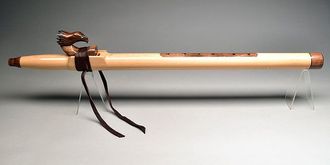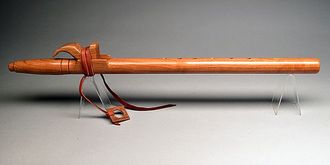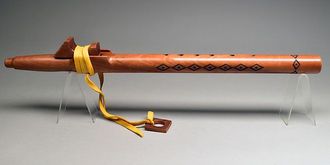I prefer to call my flutes North American-Style flutes, or Native style, because it is a more accurate description of flutes being made today. The only similarity of flutes today compared to those made by Native Americans 200 years ago is they both have two chambers, a slow air chamber and a resonant bore chamber. This trait separates the flute from all of the other flutes in the world. Flutes today are tuned to conventional European music standards, whereas those of yesterday were tuned and played by the maker to what they felt was correct.
Why play a Native American-Style flute?
Playing the flute is fun, enjoyable, loaded with healing potential. I have little musical talent however what makes the flute so much fun is its simplicity. If you love to listen to flute music, take that as a sign you are to play as well. There are two schools of flute playing, for entertainment and for spiritual healing. Play in both schools and your life becomes blessed.
For Entertainment – Play duets, play with backtracks, participate in flute circles, and connect with your body allowing the music to flow. Regardless of your mode of playing, if it feels good to you, this precisely what you are to play.
Spiritual Healing – Playing for healing can be for physical healing or to repair emotional healing. Treat the flute as a cell phone to the Spirit. Low notes are you speaking or I should say expressing your feelings to the Spirit. Whatever the high notes are played, is the Spirit speaking back to you. Put NO thought into what you are playing and you will soon discover a greater awareness of the Spirit within you.
It is my opinion that listening and/or playing the flute lulls and quiets the mind. Often the mind will say, “Give me something more interesting to evaluate.” In that bit of calm the essence of our true ethereal identity reveals itself. If you would like to view the benefits of playing and listening to North American wood flutes, check out this study by Clint Goss.
How is a sevenwinds flute unique?
I make and play flutes because the process creates peace, calms the squirrel cage in my head, and enables me to have a closer connection to Spirit. Making flutes for other people is my way of sharing the gifts that I have been given to those around me.
I consider my flutes as hand-made, though I do use power tools. One factor I have noticed at flute conventions or gatherings is to look at my display, there are a wide variety of woods, colors, shapes, sizes and designs. Typically I work in small batches of seven flutes, usually a particular key and several different types of wood.
Concert Tuning
This is a term that provides a great deal of misunderstanding. If one asks the question, “What is concert tuning?” you will receive a wide variety of interpretations. I consider a well tuned flute to be capable of playing a chromatic scale of 14 notes. However it should be noted that a few of those notes will not be as precise in tuning.
Explore Our Native American-Style Flutes
Out of Stock
Learn More About the Creation Process of Sevenwinds Flutes
-
Can you tell me a little about Seven Winds Flutes?
Seven Winds Flutes is a maker of North American wood flutes, also known as Native American-style flutes. These simple, yet elegant instruments have a unique, transcendent voice that calms and relaxes or celebrates life. They are extremely easy to play and no music knowledge is required. If you love to listen to flute music, take that as a sign your spirit is urging you to play.
-
Read More
Though we do use power tools, much of the workmanship is handmade and beautifully crafted. Upon request, a custom flute can be created to your own personal taste or essence, which can become an heirloom for generations to come. Our Native American-style flutes are crafted from a variety of soft and exotic hardwoods. With us, you can expect a quality product, a wonderful voice, and excellent customer service. Please check our customer responses on the site. We stand behind our product if it cracks or gets broken, it will be repaired for free.
So whether the flute is calling you for entertainment or for healing, please browse our assortment of Native American-style flutes and learn more about them.
How much time does it take to make one of your Native American-style flutes?
I get this question frequently and it totally depends upon the amount of carving and finish work is done. Typically a simple flute made of one wood will take about 8-10 hours. A more complex one can take 20-30 hours.
Can you tell me a little about the voices on your Native American-style flutes?
Basically the smaller the flute, the higher the voice. Large flutes create very low voices.
There is much more to the voice of the flute. In generality, a true Native American-style flute has a breathy quality. The trend seems to be towards making flutes that are more orchestra instruments capable of playing the chromatic scale with more volume and clarity having few harmonics. Again, neither is good nor bad, they are all different and it is always a personal choice in what you prefer. New flute players often say, “I like the lower-toned flutes.” I encourage new players towards the higher flutes, to begin with, because they require less breath control, and due to their size the fingering is often easier. Once one becomes familiar with the flute they can expand into the lower flutes with success, rather than frustration.
What kind of woods do you use on your Native American-style flutes?
I use all kinds of woods from the softwoods of white pine, spalted maple, cypress, cedar, redwood, poplar, brass, mahogany, sassafras, to the hardwoods like yellow and red heart, maple, zebra, Morado, tigerwood, rosewood, and others. The relationship to the material a flute is made of and the voice is relatively minor, compared to how the flute is crafted. This also depends upon how much experience you have in playing flutes. An ear that is tuned to the various flute voices will detect the difference more readily than a new player. In general the harder the wood, the bright and crisper the voice. Softwood has a softer sweeter voice. Neither is good or bad, just different.
What kind of finish do you use on your Native American-style flutes?
I have researched a number of different finishes and use only two because of the low toxicity – shellac and Crystalac. Shellac is non-toxic and contains alcohol that evaporates upon drying. I usually dip the Native American-style flutes in shellac to seal the slow air chamber and add richness to the wood color and grain. Then I finish with six to eight coats of Crystalac. Crystalac is a finish that is used on toys for toddlers. It has the lowest toxicity of any finish I have been able to find. It dries quickly, is water-based, and has no odor. It also takes french polish very well. Once the finish is applied I polish it with a paste made of mineral oil and pumice for a satin finish. For a high gloss finish, I follow it up by polishing it with a paste of mineral oil and rottenstone.
What is your return policy for your Native American-style flutes?
Return and repair policy – I have a 30-day return policy if you are not satisfied with your flute. I will repair or re-tune your flute at no charge. The policy is you pay for the shipping to me and I will pay the shipping to return it to you.
How do you ship your Native American-style flutes?
All Native American-Style flutes ship with a flute sock, for protection and all flutes, will be shipped with insured Priority Mail.
How can we contact you?
If you have any questions or want to request an mp3 file of a particular Native American-Style flutes please visit our contact form. Then simply fill in the information and I’ll be sure to get back to you as soon as possible. If you prefer to contact us by phone please don’t hesitate to call. You can reach me at (816) 217-9896.
Follow Us
In Accordance with the Indian Arts and Crafts Act
SevenWinds Flutes (though similar in style) are not Native American-Style Flutes. SevenWinds Flutes are created as North American wooden flutes, and highly influenced by a great respect for the traditional Native way taught by my Native American brothers in whose teachings I am honored to receive; and blessed by Creator to offer the wonderful gift of the flute to all. Only truth can reveal honor and respect.
























